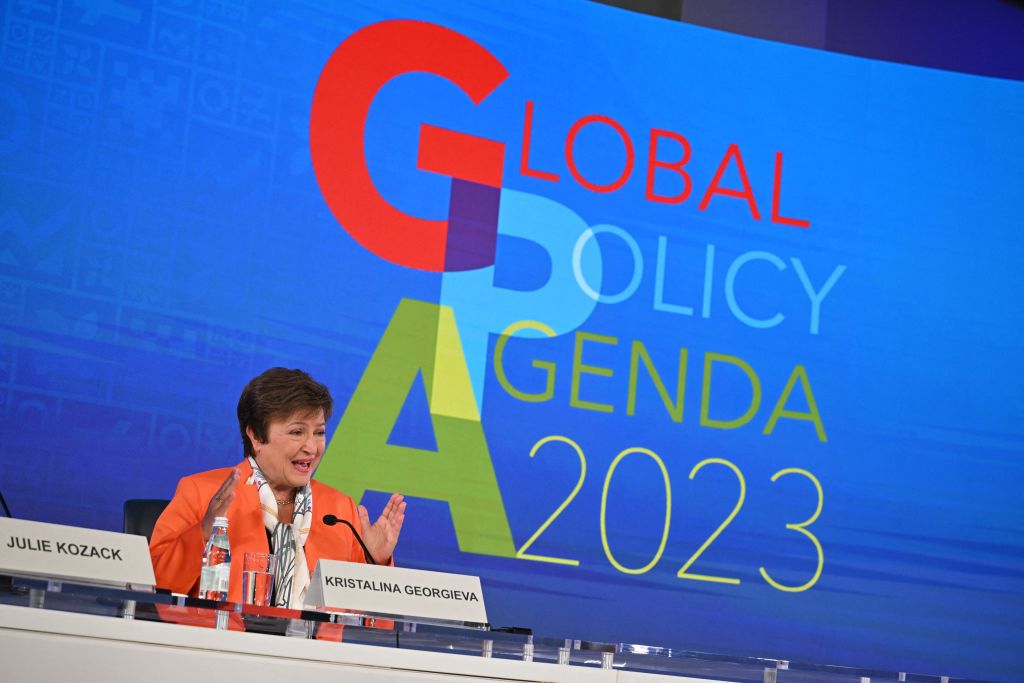
(To get this story in your inbox, subscribe to the TIME CO2 Leadership Report newsletter here.)
The biggest headlines that typically emerge from the spring meetings of the World Bank and International Monetary Fund (IMF)—which are taking place this week in Washington D.C.—tend to focus on the short-term economic outlook, and this year is no exception. The IMF cut its forecast for GDP growth this year and warned of continued economic uncertainty.
But I’m here focused on a different story: how the phalanx of economists and policymakers gathered in Washington are working to reorient the Bretton Woods institutions to address climate change. It’s a bold reform program that leaders hope will create big new opportunities for the private sector to invest in climate projects in the Global South and, in doing so, dramatically accelerate the transition to clean energy. “What the World Bank does really sets the pace,” John Kerry, President Biden’s climate envoy, told me ahead of the meetings. “It can be enormous.”
Before we get into the solutions, it’s helpful to briefly discuss the problem. The world needs to invest $5 trillion in energy annually by 2030 to facilitate the shift to clean energy, according to a joint analysis between the IMF and the International Energy Agency. And much of that investment needs to happen in emerging markets like India, where energy demand is growing rapidly.
Investing in clean energy can be difficult in these economies for a range of reasons, but more than anything there’s a finance challenge. In many places, renewable energy is cheaper over its lifetime than fossil fuels, but it requires more capital up front. Because emerging economies are much riskier places to invest, renewable energy projects cost a lot more to finance than they do elsewhere. And with interest rates high right now, the challenge is particularly tricky.
That’s where development banks and international financial institutions can step in. Everyone from finance ministers in emerging economies to private sector bankers to officials in the Biden Administration hope that these establishments can find a way to make it easier to deploy capital in the Global South.
And, if the conversations here this week are any indication, the economists seem to be working on this problem in earnest. The World Bank is currently undergoing a year-long review of its processes with an eye towards finalizing reforms in the fall, and the IMF is working to incorporate climate change into their operations.
Climate policy experts would like to see these institutions dramatically increase their lending for climate purposes as the core of these reforms. That increased lending, they hope, would in turn get “blended” with private sector investment to unlock trillions of dollars in finance for climate projects in developing economies. In other words, the World Bank and other international financial institutions would come up with a financing package for clean energy projects that combine both public and private money. To make these investments appealing to the private sector, the deals would be structured with terms that leave more risk in the hands of international financial institutions. The World Bank, for example, could agree to accept the first loss in a struggling project. A report from the blended finance network Convergence suggested that on average $1 of public money can drive $4 of investment from the private sector.
Ajay Banga, the former Mastercard CEO who is poised to become the World Bank’s next president, has suggested a range of ways the World Bank might work to attract private capital. “I’m not talking about taking away the risk the private sector should legitimately bear if they want to make profits,” Banga said in remarks at the Center for Global Development ahead of the spring meetings. “But I am talking about taking away things that are holding them back.”
Getting this right would be a big deal. A smartly structured climate finance operation would create the opportunity for banks and investors to start writing bigger checks in the Global South. This influx in capital would in turn create opportunities for businesses across the globe—from big firms that build clean energy projects to entrepreneurs developing new ways to provide low-carbon energy in these markets.
More Must-Reads from TIME
- How Donald Trump Won
- The Best Inventions of 2024
- Why Sleep Is the Key to Living Longer
- Robert Zemeckis Just Wants to Move You
- How to Break 8 Toxic Communication Habits
- Nicola Coughlan Bet on Herself—And Won
- Why Vinegar Is So Good for You
- Meet TIME's Newest Class of Next Generation Leaders
Write to Justin Worland at justin.worland@time.com